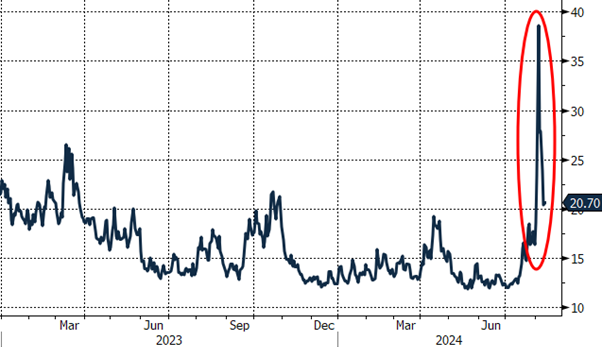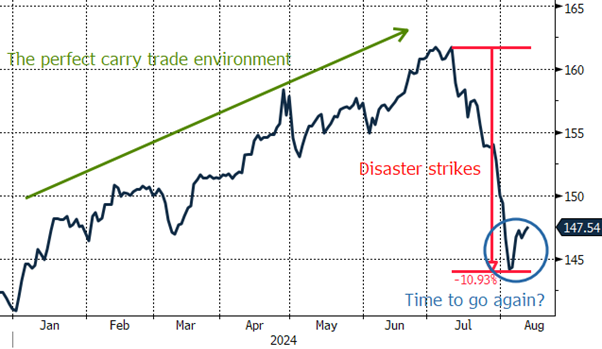
Bank of England’s Balancing Act: Rates, Growth and Inflation
7 August 2024
Market Overreaction or Necessary Adjustment? What’s Next for the Fed?
28 August 2024INSIGHT • 14 AUGUST 2024
Carry Trade Crash: A Wake-Up Call

Marc Cogliatti, Head of Capital Markets EMEA
Last week began with risk assets under heavy pressure, triggered by a weaker than expected US Non-Farm Payroll report the Friday before, with European and North American markets ending the week in ‘risk off’ mode. This continued in dramatic fashion as Asia opened on Monday. The Nikkei 225 grabbed the headlines, plunging almost 11%, while in the currency markets, the Yen continued its recent advance meaning that it was up over 10% vs the Dollar compared to where it stood a month ago.
The move in the Yen was largely driven by a mass unwinding of carry trades. The strategy has gained in popularity in recent years amid a widening of interest rate differentials – the Bank of Japan maintained its zero-rate policy while other central banks raised rates to stave off inflation. As the Yen depreciated, investors benefitted from higher foreign yields and FX gains. However, this strategy is inherently risky – a sudden shift in sentiment can lead to the ‘fast money’ disappearing, resulting in a swift reversal, faster than ‘normal’ market liquidity can accommodate.
Chart 1: VIX Index – The market’s volatility gauge

Source: Bloomberg
A second notable observation last week was that equities, bond yields and the Dollar all came under pressure in unison. In recent times, equities and bond yields have typically had an inverse relationship, with equities performing well when rates have been expected to go lower, and vice versa. Meanwhile, the Dollar has benefitted in a ‘risk off’ environment, when equities have sold off. However, this dynamic was disrupted last week, as the greenback was lower across the board, most notably against its low beta peers – not just the Yen and Swiss Franc, but also the Euro and to a lesser extent, Sterling.
Does this mark a shift in momentum?
On reflection, the move seems to be more technical than fundamental. The US economy hasn’t ground to a halt overnight, and the Bank of Japan’s policy shift was widely anticipated. With market positioning skewed very heavily, volatility at historic lows, hot money flowing in risk assets – particularly concentrated on the magnificent seven – and the Yen carry trade that has been a one way bet since the beginning of the year, a correction was inevitable. It was always a question of when, rather than if.
Chart 2: USDJPY – The carry trade

Source: Bloomberg
The market’s rapid and severe downturn was likely exacerbated by a lack of liquidity at the height of the holiday season. Understandably, this sudden volatility triggered widespread panic, but markets stabilised by Tuesday, with a rally in equities and renewed pressure on the Yen. The question now is, given the froth has been taken off the top, is it back to risk on? While impossible to answer presently, recent market behaviour suggests cautious optimism.
That said, one lesson to be learnt from this episode is that sentiment can shift rapidly and there is no room for complacency. A repeat performance could be just around the corner, most likely when least expected. Consider the potential consequences of a 5% adverse currency move on a foreign currency deal scheduled for the following day. This could mean an embarrassing call to investors to call additional capital, and in the worst case, the deal could collapse because it can’t be completed in time. Either way, implementing a robust FX risk management policy is crucial to mitigate such risks.
Be the first to know
Subscribe to our newsletter to receive exclusive Validus Insights and industry updates.

